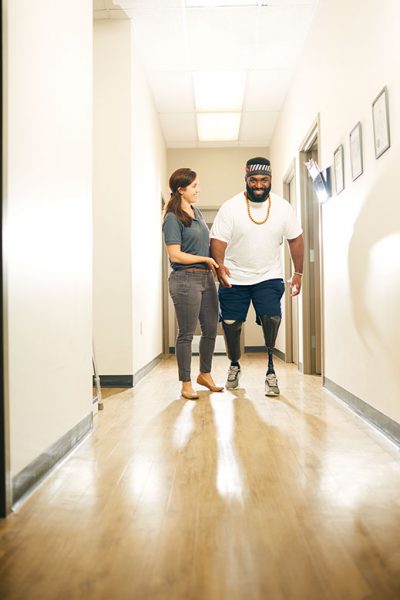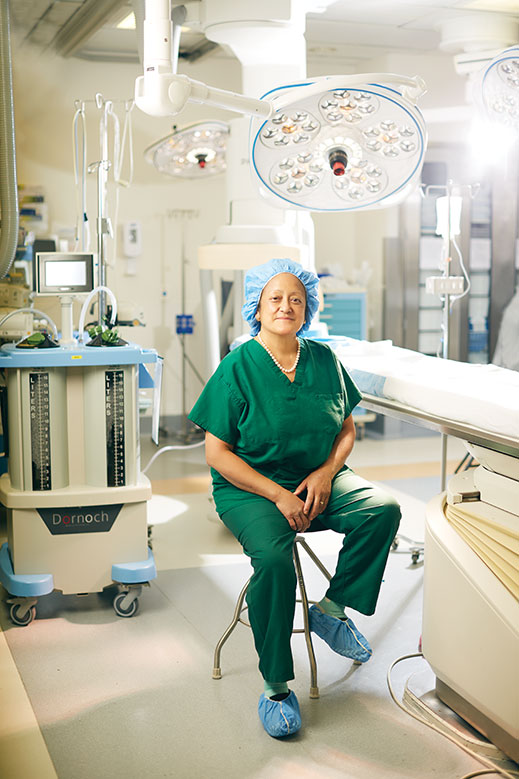
Elbow
Because fewer people are incapacitated by elbow pain, elbow replacements haven’t achieved the sophistication of hip and knee replacements. “Stresses on the elbow come from all directions,” says Tinton Falls orthopedist Dr. David Gentile, “and we haven’t yet perfected a device that allows all that motion and yet is stable and can bear a fair amount of weight.” Still, for some patients, elbow replacement can be a game changer.

Dr. Margarita Camacho is surgical director of Newark Beth Israel Medical Center’s cardiac transplant program. Photo by Yvonne Albinowski
The procedure (elbow arthroplasty): The diseased joint is removed and replaced with an implant consisting of two pieces of metal—either titanium or cobalt-chromium—attached to the bones of the arm and connected by a plastic axle.
Who’s a candidate: Because the new joint can bear only a limited amount of weight, the surgery is generally reserved for patients whose elbows are seriously compromised, particularly those with rheumatoid arthritis.
Before surgery: There are no special preparations for the procedure.
Recovery: The patient is likely to be sent to physical therapy and given exercises to perform at home. Most, says Gentile, can use their arms fairly well within three to six months.
Possible complications: Because the skin around the elbow is thin, wound breakdown is the most common complication, followed by infection in the joint.
Post recovery: The patient should be able to lift 5 to 15 pounds, but range of motion will likely be limited. For patients who haven’t been able to bring a spoon to their mouths, brush their teeth or comb their hair, the ability to perform these tasks again can be life altering.
Life span of the device: 85 percent last 10 years or more.
Breast
In the 1960s, doctors created the world’s first artificial breast implant. Made of sponge, it was never widely adopted due to its unfortunate tendency to shrink and harden. Enter silicone in 1962, a significantly more durable material that ushered in a new era of breast augmentation (a cosmetic procedure) and reconstruction (performed post mastectomy). Saline-filled implants followed two years later. Although the silicone implants were banned briefly in the 1990s in response to unfounded fears that they could trigger an autoimmune reaction, they’re back in use today.
The past six decades have seen enormous advances in the devices and their implantation, including surgeries that either spare the nipple and areola or, if necessary, remove them, but with much smaller incisions. In reconstruction, implants are now placed above, rather than beneath, the breast muscle, resulting in less discomfort and a more natural look and feel. And the type of silicone used in today’s so-called gummy-bear implants (characterized by their firmer texture) looks and feels more natural and is less likely to leak or break down.
The procedure (breast reconstruction, breast augmentation): Although patients can now choose reconstruction with their own tissue (taken from the abdomen or buttocks), the most common method of reconstruction still uses artificial implants. “Because the technology has changed considerably, you can get a very natural result using implants, with a much easier recovery process,” says Dr. Peter Hyans, a plastic surgeon in Berkeley Heights. For a majority of patients, doctors will insert balloonlike tissue expanders to stretch the skin post mastectomy. In a second surgery, the expander is removed and the implant placed above the breast muscle. Generally, in augmentation, only a portion of the implant is placed below the muscle.
Who’s a candidate: Most women can undergo augmentation for cosmetic purposes, and the majority of women can opt for reconstruction after mastectomy.
Before surgery: No particular preparation is necessary.
Recovery: After reconstruction, patients go home with drains in the chest and have limited use of their arms for the first couple of weeks. Most augmentations don’t necessitate the use of drains, and recovery is somewhat quicker, with patients returning to work a week or so after surgery. Reconstruction usually entails a three-week recovery period.
Possible complications: Both surgeries have a low complication rate, though reconstructive patients can develop fluid around the implant. The most significant complications involve the implants rupturing over time or causing the buildup of painful scar tissue. If that happens, a new implant can be inserted. Some augmentation patients will require removal of the implant within a decade, and the number of patients who need revisionary surgery is slightly higher for reconstructive patients.
Life span of the device: Approximately 20 years.
Heart Valve
Within the human heart, four valves open and close like tiny doors, allowing blood to circulate to the lungs and the rest of the body. Sometimes those valves don’t open or close correctly, conditions that often lead to congestive heart failure. For half a century, doctors have been able to replace faulty heart valves with artificial versions, originally made of metal, and now also constructed of specially treated cow or pig tissue. Today, the procedure itself, which had previously always entailed open-heart surgery, is experiencing what Dr. Robert Kipperman, a cardiologist at Morristown Medical Center, calls “a big transition” to minimally invasive surgery performed through a catheter. Currently, these transcatheter replacements are done only on the aortic valve, but Kipperman believes they one day will be the standard of care for all valve replacements.
The procedure (aortic, tricuspid, pulmonary, or mitral replacement, depending on the valve): In the traditional open-heart procedure, the heart is exposed through an incision in the chest and then stopped, while a bypass machine circulates blood throughout the body, the old valve is cut out and replaced. The newer procedure—transcatheter aortic valve replacement (TAVR), currently done only on the aortic valve—is performed on a beating heart, through a catheter in the groin or shoulder.
Who’s a candidate: Patients whose valve stenosis (in which the valve doesn’t open properly) has led to congestive heart failure.
Before surgery: Transcatheter patients are evaluated to determine if postsurgical rehab will be necessary.
Recovery: Open-heart patients spend four or five days in the hospital and four to six weeks recovering at home while undergoing rehabilitative therapy to help regain strength. “You usually don’t feel better than you did before the surgery for about two months,” notes Kipperman. Transcatheter patients go home in the first few days post surgery, “and there’s very little recovery [time],” Kipperman says—although some patients may require rehab.
Possible complications: About 1-2 percent of patients experience stroke and 5 to 10 percent require a pacemaker.
Post recovery: The weakness and shortness of breath that characterize congestive heart failure should be gone, and normal activities can be resumed.
Life span of the device: Metal valves can last up to 30 years; tissue valves usually last 10–20.




Thanks for this very informative article.
Its amazing what the new world of prosthetics is doing ! Just for an FYI, medical clearance is generally routine for any of these surgeries. Plus many hospitals and surgeons implement a preadmission infection screening and prevention routine.